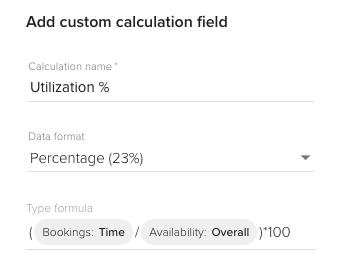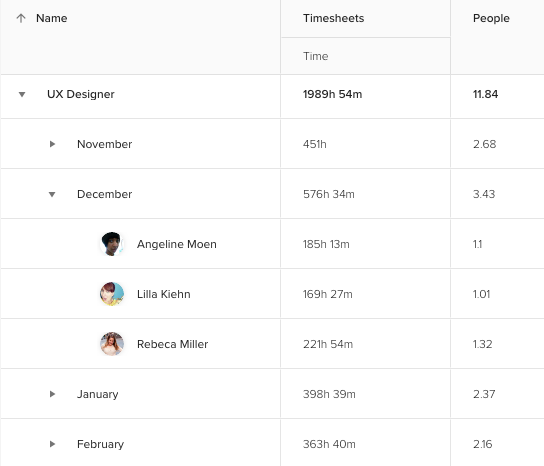Come si legge di seguito, secondo l'Institute of Business Forecasting and Planning, ogni decisione e azione si basa - non necessariamente in modo consapevole - sulla previsione delle risorse. Questo articolo si basa sulle esperienze del Direttore dell'Ufficio e del Responsabile delle Finanze.
L'articolo contiene:
- Un confronto tra le definizioni di previsione delle risorse umane
- Rapporto di previsione sull'utilizzo del team
- Analisi delle tendenze e ruolo utile del software di gestione delle risorse previsione delle risorse
Insieme ai nostri ospiti, Piotr e Iwona, voglio mostrarvi che una pianificatore di risorse possono fornire dati per approfondire questa comprensione e, di conseguenza, effettuare scelte di previsione più sicure.

Iwona Marciniak - Office Manager presso Le Polish Bureau, il dipartimento tecnico di una rinomata casa di produzione, UNIT9.

Piotr Bandosz - Responsabile delle finanze e delle persone di Apptension, una software house creativa di 50 persone con sede a Poznań, in Polonia.
Usare la storia per prevedere il futuro - qualche parola prima di parlare di previsione delle risorse umane
"(...) che ve ne rendiate conto o meno, praticamente ogni decisione e processo aziendale si basa su una previsione".
(Istituto di previsione e pianificazione aziendale)
È ovviamente vero che, senza il passato, non c'è futuro - e questo è un discorso elevato. Ma, detto più chiaramente, qualsiasi previsione - anche nella vita privata - si basa su una miscela di dati (tratti dalla propria esperienza e forniti da colleghi o strumenti di supporto) e di immaginazione.

La creazione del futuro o la semplice realizzazione degli obiettivi prefissati e il superamento dei compiti e delle sfide che si presenteranno sulla strada del successo si basano sempre su elementi come i dati e l'esperienza che aiutano a risolvere i problemi e a scegliere la direzione giusta.
(...) la previsione è il tentativo di prevedere i risultati futuri sulla base degli eventi passati e delle intuizioni del management.
(WoltersKluwer.com)
La previsione - che si parli di meteo, di comportamento umano o animale, di finanza, di affari o semplicemente di risorse umane - è il processo di utilizzo dei dati, delle intuizioni e dell'esperienza per fare previsioni e prepararsi a soddisfare un'esigenza specifica, o un'esigenza aziendale, per dirla senza mezzi termini.
Come si raccolgono i dati a supporto delle decisioni di previsione delle risorse umane?
Dal significato all'azione - comprensione della previsione delle risorse umane
Tenendo presente quanto sopra, possiamo prevedere il significato di previsione delle risorse umane.
La previsione delle risorse umane è il processo di determinazione o previsione del fabbisogno di personale di un'azienda utilizzando i dati esistenti.
(the-definition.com)
In questo senso, l'accento è posto sulla garanzia di un numero sufficiente e atteso di dipendenti adeguatamente qualificati - attesi dal punto di vista aziendale o commerciale. L'obiettivo è garantire la continuità dell'attività, realizzando le esigenze aziendali proprio grazie a dipendenti qualificati.

Questo significato è abbastanza vicino alla pianificazione della capacità, un termine molto popolare tra i responsabili delle risorse e dei progetti. Per loro, la pianificazione della capacità consiste nell'avere il giusto numero di dipendenti (adeguatamente formati e qualificati) che possano portare a termine con successo il progetto o il compito.
Quindi, la previsione delle risorse umane è... prevedere la domanda e l'offerta. Può riferirsi a un numero di lavoratori, a particolari competenze attese o ad attrezzature per ufficio. Nelle risorse umane, prevedere significa:
valutare il numero di dipendenti e calcolare le competenze, le attrezzature e le risorse necessarie per soddisfare le esigenze dei dipendenti e raggiungere gli obiettivi aziendali.
(rovva.com)
Vi suona familiare se paragoniamo quanto sopra alle definizioni di programmazione delle risorse o addirittura di gestione delle risorse?
Riassumendo questo capitolo, la previsione delle risorse umane è un processo di previsione - basato sui dati, sulle esigenze dell'azienda e sui dipendenti che attualmente lavorano per l'azienda e sui loro indicatori di impegno e produttività - di chi dovrebbe essere impiegato. Impiegati in termini di padronanza e forza lavoro. La previsione delle risorse umane è finalizzata a soddisfare le richieste dei progetti futuri. È un'operazione che richiede la giusta comprensione di ciò che accade nella vostra azienda.
Rapporto di previsione sull'utilizzo del team
Piotr è uno degli utenti OG di Teamdeck, che ha utilizzato l'applicazione fin dal suo lancio in versione beta. Non c'è da stupirsi che abbia sviluppato un paio di preferenze quando si tratta di automatizzare il lavoro e ricavare valore dai dati. Uno dei suoi report preferiti è la previsione di produzione a 3 mesi.
Si basa sulla disponibilità futura del team e sulle prenotazioni di progetti già assegnati.

CONSIGLIO: Utilizzate una funzione chiamata Aggiungere un campo di calcolo personalizzato per creare la colonna Utilizzo.

In qualità di Head of Finance & People, Piotr è in grado di utilizzare questo report per entrambi gli aspetti del suo lavoro. Gli fornisce una solida panoramica della pipeline di produzione pianificata di Apptension: se i valori di utilizzo sono inferiori al previsto, può parlare con il team di vendita e verificare se c'è la possibilità di chiudere altri contratti nelle prossime settimane.
CONSIGLIO: È possibile etichettare diversi tipi di prenotazioni con dei tag, ad esempio "provvisorio" per le prenotazioni non ancora confermate ma per le quali sono già stati presi degli accordi.
Questa semplice tabella è anche un buon spunto per la previsione delle risorse umane
Piotr può analizzare l'utilizzo di particolari persone o reparti. In questo modo, sa quali ruoli saranno richiesti a breve e può pianificare i processi di assunzione di conseguenza.
CONSIGLIO: I campi personalizzati funzionano come etichette per i progetti e le persone in Teamdeck. Rendono più facile l'ordinamento dei dati in categorie, come ad esempio i dipartimenti. Sia Iwona che Piotr hanno aggiunto un tag "job title" ai loro compagni di squadra per filtrarli in base alle competenze.

Osservando la tabella qui sopra, si nota che anche se il reparto creativo nel suo complesso sembra essere ragionevolmente utilizzato per i prossimi mesi, se si scende nei dati si nota che avremmo bisogno di un po' di aiuto per il copywriting, dato che Luisa ha molto da fare.
La previsione a 3 mesi è utile anche per valutare se un determinato ruolo sarà richiesto per un periodo di tempo più lungo o se si tratta di un lavoro breve più adatto a un freelance.
Previsione delle risorse umane basata su dati storici
Iwona sottolinea che l'accesso ai dati storici è estremamente utile anche quando si cerca di ottimizzare i processi di assunzione futuri. L'analisi dei dati degli ultimi mesi e anni permette di individuare le tendenze dei dati e di fare previsioni più accurate. Ad esempio, alcune competenze si sono rivelate più richieste in determinati mesi. Ora che il team è in grado di prevedere un'imminente necessità di assunzione, il processo può essere pianificato in anticipo.
Se non si dispone di dati sufficienti per analizzare gli anni precedenti, anche lo storico recente può essere d'aiuto. Il report dei dati storici si basa sui fogli di presenza delle persone e, come ammette la stessa Iwona, "ha richiesto circa 5 minuti per essere preparato".

Il rapporto di Iwona presenta tre colonne:
- categorie di dipendenti in base ai loro titoli di lavoro, dopo aver espanso ogni categoria si possono vedere i mesi e poi le persone (usare il tasto raggruppamento per poter inserire i dati in quell'ordine)
- i fogli di presenza prelevati direttamente da Teamdeck - software di gestione delle risorse
- il numero di persone necessarie per erogare il numero di ore rilevato nella seconda colonna
CONSIGLIO: La colonna Persone è il cosiddetto calcolo personalizzato e la formula è la seguente:
Persone = fogli di presenza / 60 / 168
Perché 168? È il numero medio di ore nel mese lavorativo. Questo numero può variare da Paese a Paese: utilizzate il valore che ha più senso nel vostro caso.
Questo report è molto interessante quando si espandono le righe e si confronta il carico di lavoro mensile con il numero di persone effettivamente presenti a bordo.

Quella che vedete nell'immagine è la ripartizione dei timesheet mensili di un team UX immaginario. Ci sono tre persone a bordo e, per la maggior parte del tempo, si tratta della cifra giusta per completare il lavoro (il valore della Persone non supera i 3). Dicembre, tuttavia, sembra essere stato molto impegnativo per il team UX. Tutti i membri del team hanno registrato più tempo del solito e il calcolo mostra che sarebbero necessarie più di 3 persone (3,43 in realtà) per completare questo lavoro entro i tempi regolari.
Può darsi che questo particolare mese di dicembre sia stato straordinariamente impegnativo o forse si tratta di un modello emergente. In ogni caso, avete tutte le ragioni per guardare il carico di lavoro dei designer UX e pianificare nuove assunzioni, se necessario.
CONSIGLIO: I report dei timesheet sono anche un'ottima base per calcolare le buste paga dei vostri dipendenti.
Le sfide della previsione delle risorse umane e come rispondere ad esse
Sono molteplici i fattori da considerare quando si tratta di risorsa di pianificazione richiesta alle agenzie. Le cose cambiano rapidamente, sia in termini di nuovi progetti in produzione che di nuove competenze necessarie per realizzarli. Dovete decidere se cercare persone da inserire nel vostro team o se contribuire ai progetti come freelance. Poi, naturalmente, c'è il costo del processo di reclutamento vero e proprio.

E le conseguenze di processi di assunzione non tempestivi? Le agenzie con un eccesso di personale possono facilmente perdere la loro liquidità finanziaria, ma non avere abbastanza risorse può mettere a repentaglio i progetti imminenti o danneggiare le relazioni con i clienti accuratamente create. È chiaro che la posta in gioco è alta.
Fortunatamente, esistono dati affidabili su:
- progetti confermati (o sostanzialmente confermati in attesa del via definitivo), la loro durata stimata e i ruoli necessari per realizzarli,
- disponibilità futura dei vostri compagni di squadra,
- registrazioni passate: fogli di presenza, utilizzo, stime e dati effettivi,
vi aiuterà enormemente. La previsione delle risorse umane basata sui dati inizia con la raccolta di informazioni appropriate, preferibilmente in tempo reale. Le analisi presentate in questo articolo sono state acquisite da Teamdeck, un software creato su misura per supportare le agenzie, le software house e le startup nella gestione delle risorse umane. gestione delle risorse del progetto.
Avete già un account? Andate alla sezione rapporti e create il vostro cruscotto di analisi.
Sei nuovo di Teamdeck? La creazione di un account è gratuita e richiede solo un paio di minuti.


